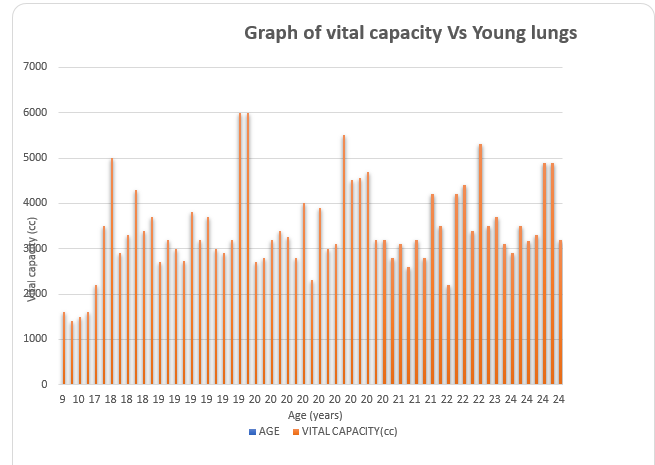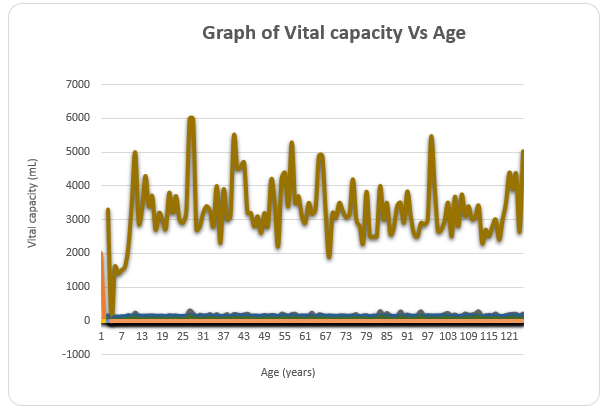
Background
The above diagram is a representation of the lung volumes that occur during breathing. The lung capacity is usually calculated in terms of the functionality of the quantity of air in milliliters for every kilogram of weight of the body. The capacity of the lung varies with the gender of the person in question. The equation for women in the range of 50 to 60 milligrams for every kilogram of body weight of air (55mlxkg), and when applying for men when looking at 70milliliters per kilogram the equation for the body weight (70 ml x kg)
What is vital capacity?
The vital capacity can be viewed as the upper limit of the quantity of oxygen (air) that an individual can release forcefully from the lungs during the utmost inspiration. Usually, the values of the vital capacity of a normal person may vary between 3500 cc and 6000 cc. Varied values are obtained depending on certain factors including age, sex, height and different habits like smoking among other activities that have an effect on the heart (Berne 12; Elaine 112; Jordan1320).
The individual Vital capacity of the individual is usually measured using a spirometer that cans either wet or regular type. Vital capacity is measured in milliliters (ml). It can be equated to the sum of the inspiratory reserve volume (IRV) and the tidal volume (TV) plus the expiratory ERV (reserve volume)
VC= IRV + TV + ERV
Why is it important?
With the combination with other physiological processes of the body and the vital capacity can be used as the diagnostic tool and can also be employed in identifying the underlying diseases and conditions. It can also be used as a measure of fitness levels of a person. The values obtained from the spirometer readings may be interpreted to show the level of fitness of a person and advice can therefore be given accordingly. Usually, a person found with less than ¾ of expected levels of vital capacity is advised to get medical attention before they can engage in rigorous physical activities.
Why is it a good idea to have a large vital capacity?
A person with a large vital capacity has a large reserve of air and sufficient muscle strength to sustain ventilation. By this, there is increased ability to breathe in more air in one breathing and the oxygen taken in can be used to cater for the increased cell activities. Sustained ventilation is therefore possible and this boosts the fitness and endurance levels of the person.
Why is unfortunate to have a small vital capacity?
A small vital capacity may be an indication of an imminent respiratory failure. This is because the person has very minimal reserve to reverse the effects of atelectasis, to coughs, to mobilize secretions and also to sustain ventilation. What are some examples of how varying vital capacity changes your day to day life?
The normal adult lung vital capacity is 3 to 5 liters (3,000 to 5,000 milliliters). These values are affected by various factors that are encountered in daily life. Some of the are sex, age, height, body weight, smoking habits, exercising and also genetic factors play a role in the vital capacity values. The lungs of a child grow and increase in size as the child grows old. This therefore means that the lung capacity increases accordingly. Hence the lung capacity is larger in older people than in younger ones.
However, after the age of 20 years, the lung capacity begins to decrease, probably due to the decrease in stretchiness and elasticity of muscles as age catches up. On average, up to 20 to 25ml of lung capacity is lost for every 10 years of growth and this translates to a decrease in vital capacity too.
Physical fitness may lead to a change lung capacity. This is because the lung capacity is increases to enable intake of more oxygen for use by the body cell for physiological processes while exhaling carbon dioxide gas. Increase in the amount of air that can be breathed in and out is increased and this in turn increases vital capacity. However, this differs between males and females due to physique and body structure.
Describe relevant observations
It was observed that the vital capacity differed from person to person and also depended on the various factors. The vital capacities were seen to vary across the age brackets and also within the same ages. The vital capacity was seen to be higher in some non-exercising people and also some exercising people. Vital capacity also was observed to vary with height. There was no clear trend that was observed.
Hypotheses
- Smoking reduces the vital capacity of a person.
- Vital capacity increases with an increase in height of the subject.
The raw data and graphical results are attached in the excel worksheet.
This is done to show the Hypotheses
Findings from the raw data
The raw data showed a trend whereby the vital capacity increased as from the age of 18 and hit a high value at age 19. Then the values decreased and were relatively constant in the twenties. These further decreased generally as the ages went to forties and fifties. The vital capacities were observed to be generally high in males than in females of the same ages.
Vital capacities were observed to change with weight of the subjects. However, there was no clear cut relation of the effect of weight on vital capacity. Also, there was no clear cut effect of exercise on vital capacity observed from the results. There was a varied recording of values. It can be concluded that these various factors namely age, weight, height, exercise and smoking habits work together to determine the vital capacity of a person.
The graphs of the data obtained are shown in figure1 and figure 2 below:


State what the graph is showing you
From the graph, it can be deduced that most of the vital capacities range between 3000cc and 4000 cc. The highest recorded vital capacity reading was 6000 cc while the least recorded vital capacity reading was just below 2000cc. Also from the graph, the vital capacities don’t vary very significantly from the age of 19 to 25 but are within the same values and they have an average value of about 3100cc. There was no value of above 6000cc that was recorded in this graph. The least value recorded is about 1500cc. The 0 value is an error in the graph computation.
Works Cited
Berne, Robert and Levy, Matthew. Physiology. 3 ed. Chicago: Mosby, Inc., 2008.
Elaine N. Marieb, Susan J. Mitchell, Timothy Stabler, Peter Zao Human Anatomy and Physiology Lab Manual, Main Version (8th Edition) 2007.
Guenette, Jordan, With, Jonathan, et al. “Respiratory mechanics during exercise in endurance-trained men and women.” J Physiol Journal, 581.3 (2007): 1309-1322.